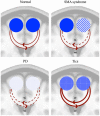Insights from the supplementary motor area syndrome in balancing movement initiation and inhibition
- PMID: 25506324
- PMCID: PMC4246659
- DOI: 10.3389/fnhum.2014.00960
Insights from the supplementary motor area syndrome in balancing movement initiation and inhibition
Erratum in
-
Erratum on: Insights from the supplementary motor area syndrome in balancing movement initiation and inhibition.Front Hum Neurosci. 2015 Jan 22;9:19. doi: 10.3389/fnhum.2015.00019. eCollection 2015. Front Hum Neurosci. 2015. PMID: 25655776 Free PMC article.
Abstract
The supplementary motor area (SMA) syndrome is a characteristic neurosurgical syndrome that can occur after unilateral resection of the SMA. Clinical symptoms may vary from none to a global akinesia, predominantly on the contralateral side, with preserved muscle strength and mutism. A remarkable feature is that these symptoms completely resolve within weeks to months, leaving only a disturbance in alternating bimanual movements. In this review we give an overview of the old and new insights from the SMA syndrome and extrapolate these findings to seemingly unrelated diseases and symptoms such as Parkinson's disease (PD) and tics. Furthermore, we integrate findings from lesion, stimulation and functional imaging studies to provide insight in the motor function of the SMA.
Keywords: Parkinson’s disease; akinetic mutism; neurosurgery; supplementary motor area (SMA); supplementary motor area syndrome; tic disorders.
Figures



References
LinkOut - more resources
Full Text Sources
Other Literature Sources

